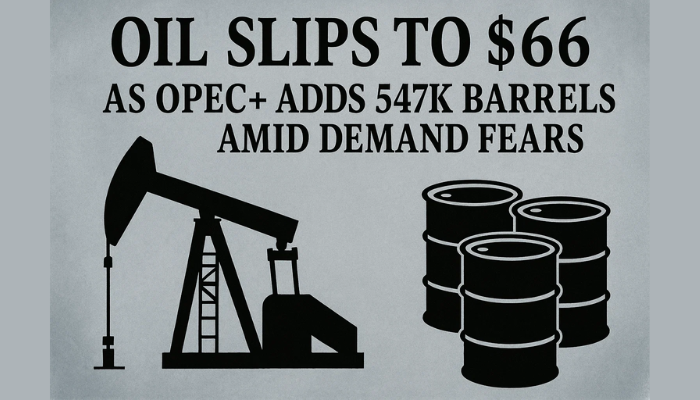Oil markets extended their slide on Tuesday as concerns over rising supply and weakening global demand continued to pressure prices. Both Brent crude and West Texas Intermediate (WTI) posted their fourth consecutive daily loss, retreating to their lowest levels in a week.
By 04:24 GMT, Brent crude slipped 0.16% to $68.65 a barrel, while WTI fell 0.18% to $66.17. The modest declines follow a 1% drop in the previous session, reflecting investor uncertainty over OPEC+ policy decisions and economic conditions in major markets.
The Organization of the Petroleum Exporting Countries and its allies, OPEC+, agreed on Sunday to increase output by 547,000 barrels per day (bpd) in September. This decision effectively unwinds a significant portion of the 2.5 million bpd in voluntary production cuts, amounting to 2.4% of global demand. Analysts warn that the actual increase in physical supply may be lower, as not all producers can meet their targets.
Priyanka Sachdeva, senior market analyst at Phillip Nova, noted that “excess capacity from OPEC+ is offsetting geopolitical risks like potential reductions in Russian barrels.”
Demand Concerns Cloud Market Outlook
Even as supply climbs, demand signals are flashing caution. Fears of a U.S. recession are gaining traction, with JPMorgan analysts warning that labor market momentum has stalled, weakening consumption outlook in the world’s largest economy.
Meanwhile, China’s recent Politburo meeting emphasized long-term structural reforms over immediate stimulus, dampening hopes for a rebound in energy demand from the world’s second-largest oil consumer.
Other key demand-related developments include:
- Slower industrial activity in Europe and Asia
- Muted travel and transport fuel demand projections
- Tightening monetary policy in major economies
The combination of macroeconomic stressors is shifting market focus away from earlier fears of supply disruption and toward a potential supply glut.
U.S. Tariff Moves Add New Layer of Risk
Geopolitical tensions are also impacting oil markets. President Trump has proposed 100% secondary tariffs on countries purchasing Russian oil, with India in the spotlight following its continued imports.
In July, the U.S. had already imposed a 25% tariff on Indian goods, escalating trade tensions. India, which imported 1.75 million bpd of Russian crude from January to June, called the latest threat “unjustified” and pledged to defend its economic interests.
Market Watchpoints:
- Will further tariffs slow fuel consumption?
- How will India respond to U.S. pressure on Russian oil?
- Could weaker global growth outweigh supply cuts?
With more tariff announcements potentially on the horizon, traders are bracing for further volatility in both crude prices and energy-linked assets.


